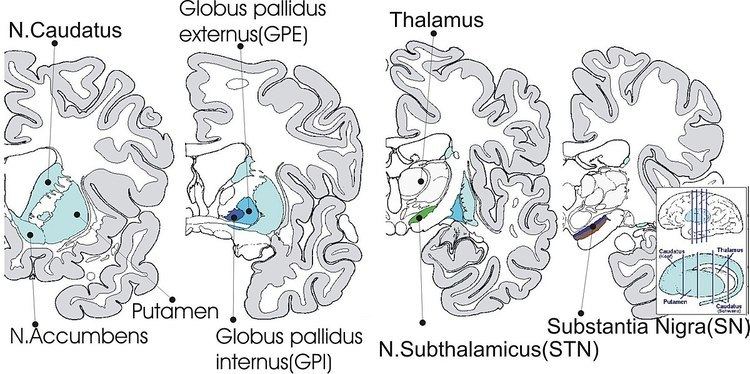NeuroNames hier-215 FMA 61840 | TA A14.1.09.511 | |
 | ||
Latin Globus pallidus medialis,
globus pallidus internus NeuroLex ID Globus pallidus internal segment | ||
The medial globus pallidus (or internal, GPi) is one of the output nuclei of the basal ganglia (the other being the substantia nigra pars reticulata). The GABA-containing neurons send their axons to specific nuclei of the dorsal thalamus (VA and VL), to the centromedian complex and to the pedunculopontine complex.
Contents
The efferent bundle is constituted first of the ansa and fasciculus lenticularis, then crosses the internal capsule as the Edinger's comb system then arrives at the laterosuperior corner of the subthalamic nucleus and constitutes the field H2 of Forel, then H, and suddenly changes its direction to form field H1 that goes to the inferior part of the thalamus. The distribution of axonal islands is widespread in the lateral region of the thalamus. The innervation of the central region is done by collaterals.
The medial globus pallidus contains GABAergic neurons, which allow for its inhibitory function. As the medial globus pallidus, along with the substantia nigra pars reticulata, forms the output of the basal ganglia, these neurons extend to the thalamus, the centromedian complex and the pedunculopontine complex.
Function
The medial globus pallidus acts to tonically inhibit the ventral lateral nucleus and ventral anterior nucleus of the thalamus. As these two nuclei are needed for movement planning, this inhibition restricts movement initiation and prevents unwanted movements.
The Direct Striatopallidal Pathway
The medial globus pallidus receives inhibitory GABAergic signals from the striatum when a movement requirement is signaled from the cerebral cortex. As the medial globus pallidus is one of the direct output centers of the basal ganglia, this causes disinihibtion of the thalamus, increasing overall ease of initiating and maintaining movement. As this pathway only contains one synapse (from the striatum to the medial globus pallidus), it is considered a direct pathway.
The Direct Striatopallidal Pathway is modulated by stimulation of the medial globus pallidus by the lateral globus pallidus and subthalamic nucleus, via the Indirect Striatopallidal Pathway.
Pathology
Dysfunction of the medial globus pallidus has been correlated to the following conditions:
Deep brain stimulation
Deep brain stimulation (DBS) is a treatment by which regulated electrical pulses are sent to specifically targeted areas, and has been used on the medial globus pallidus to treat a variety of medical conditions.
DBS has been applied to patients with Tardive Dyskinesia, and the majority saw more than 50% improvement in symptoms. Tourette Syndrome patients have also benefited from this treatment, showing over 50% improvement in tic severity (compulsive disabling motor tics are symptoms of Tourette patients). The medial globus pallidus is also considered a "highly effective target for neuromodulation" when using deep brain stimulation on Parkinson's Disease patients.
